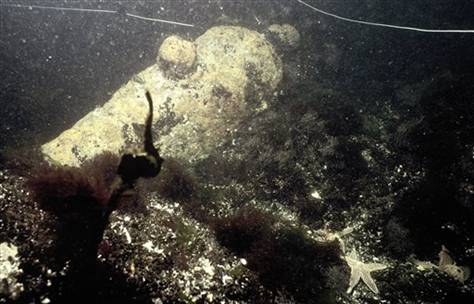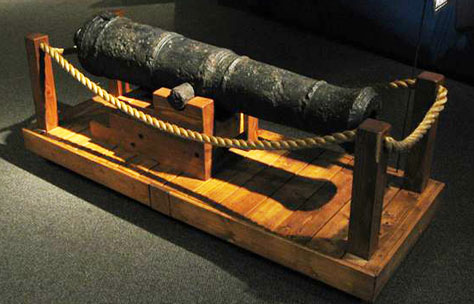 200-Year-Old Battleship
200-Year-Old Battleship
Divers Find 1811 Wreck
On January 7, 2011, Connecticut divers Charles Buffum and Craig Harger announced the discovery of a shipwreck off the coast of Rhode Isand that matched the location and size of the sunken battleship, the USS Revenge. Their finds, although not conclusively tied to that particular ship, include the sighting of cannons and an anchor.
 The Navy purchased the 70-foot Baltimore-built schooner Ranger in December, 1806. She was renamed and commissioned as Revenge. In January 1811, Revenge was under the command of Lt. Oliver Hazard Perry, charting coastal waters and harbors between Rhode Island and New York. On January 9, 1811, she ran aground on a reef off of Watch Hill, Rhode Island, while attempting to navigate a hazardous stretch of water in heavy fog. Cargo was unloaded but the ship drifed away and eventually sank. The full story of the shipwreck find can be found here.
The Navy purchased the 70-foot Baltimore-built schooner Ranger in December, 1806. She was renamed and commissioned as Revenge. In January 1811, Revenge was under the command of Lt. Oliver Hazard Perry, charting coastal waters and harbors between Rhode Island and New York. On January 9, 1811, she ran aground on a reef off of Watch Hill, Rhode Island, while attempting to navigate a hazardous stretch of water in heavy fog. Cargo was unloaded but the ship drifed away and eventually sank. The full story of the shipwreck find can be found here.


Tom Packer / AP / 2006 photo
L: Submerged cannon, believed to be from the Revenge; R: 1812 cannon in the Treasure! exhibit
Ties to Treasure! Exhibit
A cannon recovered from Lake Erie is a featured artifact in the Treasure! exhibit. Our cannon was recovered by a diving club in the 1960s and it is believed to be from the HMS Detroit (aka Adams) that was scuttled during a battle in the War of 1812. The Detroit had previously been the brig Adams, a 200-ton vessel built on the River Rouge in 1799. Adams was in drydock at Detroit for repairs and refitting when war broke out, and was surrendered to the British along with the rest of the city. The British armed the prize and commissioned her as HMS Detroit. She and HMS Caledonia gave the British undisputed control of Lake Erie.
This changed early on the morning of October 9, 1812 when a boat expedition commanded by Lt. Jesse D. Elliott (who later fought under the command of Oliver Hazard Perry) captured the two vessels right under the muzzles of the guns at Fort Erie. Caledonia made it safely to the temporary American base at Black Rock, but Detroit, owing to light wind, was swept away by the Niagara River's strong current and was forced to anchor within range of British guns.
An artillery duel ensued. Elliott brought all his guns to his engaged side and continued the cannonade until his supply of ammunition was exhausted. He cut the cable and the brig drifted down the river. She grounded on Squaw Island within range of both British and American batteries. Elliott and his men left the ship and, almost immediately, British soldiers took brief possession of the brig. American guns soon drove them out and both sides began pounding her with gunfire. The Americans finally set fire to and destroyed the battered hulk, sinking it in Lake Erie. Two hundred years later, one of its cannons is now part of our exhibit.
Dig Deeper
Tour Schedule
Start Hunting
Treasures for Teachers
About the Exhibit